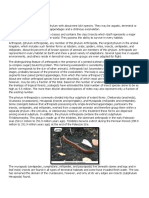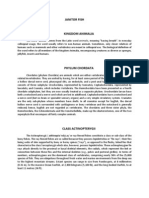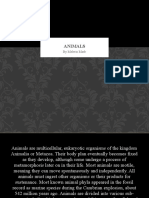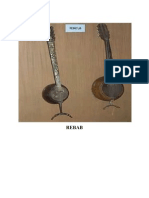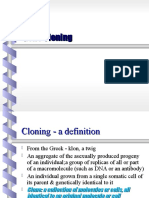Professional Documents
Culture Documents
Protozoa: Protozoa (From The Greek Words Proto, Meaning "First", and Zoa, Meaning "Animals") Is A Grouping
Protozoa: Protozoa (From The Greek Words Proto, Meaning "First", and Zoa, Meaning "Animals") Is A Grouping
Uploaded by
gabrielluis08Original Description:
Original Title
Copyright
Available Formats
Share this document
Did you find this document useful?
Is this content inappropriate?
Report this DocumentCopyright:
Available Formats
Protozoa: Protozoa (From The Greek Words Proto, Meaning "First", and Zoa, Meaning "Animals") Is A Grouping
Protozoa: Protozoa (From The Greek Words Proto, Meaning "First", and Zoa, Meaning "Animals") Is A Grouping
Uploaded by
gabrielluis08Copyright:
Available Formats
PROTOZOA
Protozoa (from the Greek words proto, meaning "first", and zoa, meaning "animals") is a grouping of eukaryotes, many of which are motile. Terminology The word protozoan was originally an adjective but can also be used as a noun. Protozoans are referred to generally as animal-like protists because of movement (motile). However, both protozoa and protists are paraphyletic groups (not including all genetic relatives of the group). For example, Entamoeba is more closely related to humans than to Euglena. "Protozoa" is considered an outdated classification in more formal contexts. However, the term is still used in children's education. While there is no exact definition for the term protozoan, it often refers to a unicellular heterotrophic protist, such as the amoeba and ciliates. The term algae is used for microorganisms that photosynthesize. However, the distinction between protozoa and algae is often vague. For example, the algae Dinobryon haschloroplasts for photosynthesis, but it can also feed on organic matter and is motile. Protozoa are their own "kingdom" by the Integrated Taxonomic Information System 2009 classification. It is sometimes considered a subkingdom. It was traditionally considered a phylum under Animalia.
SPONGE
Sponges are animals of the phylum Porifera (meaning "pore bearer"; pronounced /prfr/). Their bodies consist of jelly-like mesohyl sandwiched between two thin layers of cells. While all animals have unspecialized cells that can transform into specialized cells, sponges are unique in having some specialized cells that can transform into other types, often migrating between the main cell layers and the mesohyl in the process. Sponges do not havenervous, digestive or circulatory systems. Instead, most rely on maintaining a constant water flow through their bodies to obtain food and oxygen and to remove wastes, and the shapes of their bodies are adapted to maximize the efficiency of the water flow. All are sessile aquatic animals and, although there are freshwater species, the great majority are marine (salt water) species, ranging from tidal zones to depths exceeding 8,800 metres (5.5 mi). While most of the approximately 5,00010,000 known species feed on bacteria and other food particles in the water, some host photosynthesizing micro-organisms as endosymbionts and these alliances often produce more food and oxygen than they consume. A few species of sponge that live in food-poor environments have become carnivoresthat prey mainly on small crustaceans.
COELENTERATA
Coelenterata is an obsolete long term encompassing two animal phyla, the Ctenophora (comb jellies) and the Cnidaria(coral animals, true jellies, sea anemones, sea pens, and their allies). The name comes from the Greek "koilos" ("full bellied"), referring to the hollow body cavity common to these two phyla. They have very simple tissue organization, with only two layers of cells, external and internal.
FLATWORM
The flatworms, known in scientific literature as Platyhelminthes or Plathelminthes (from the Greek , platy, meaning "flat" and (root: -), helminth-, meaning worm) are a phylum of relatively simple bilaterian,unsegmented, soft-bodied invertebrate animals. Unlike other bilaterians, they have no body cavity, and no specializedcirculatory and respiratory organs, which restricts them to flattened shapes that allow oxygen and nutrients to pass through their bodies by diffusion.
NEMATODE
The nematodes (pronounced /nmtodz/) or roundworms (phylum Nematoda) are the most diverse phylum ofpseudocoelomates, and one of the most diverse of all animals. Nematode species are very difficult to distinguish; over 28,000 have been described,[1] of which over 16,000 are parasitic. It has been estimated that the total number of nematode species might be approximately 1,000,000. Unlike cnidarians or flatworms, roundworms have adigestive system that is like a tube with openings at both ends.
ANNELID
The annelids (also called "ringed worms"), formally called Annelida (from French annels "ringed ones", ultimately fromLatin anellus "little ring"[2]), are a large phylum of segmented worms, with over 17,000 modern species includingragworms, earthworms and leeches. They are found in marine environments from tidal zones to hydrothermal vents, in freshwater, and in moist terrestrial environments. Although most textbooks still use the traditional division intopolychaetes (almost all marine), oligochaetes (which include earthworms) and leech-like species, research since 1997 has radically changed this scheme, viewing leeches as a sub-group of oligochaetes and oligochaetes as a sub-group of polychaetes. In addition, the Pogonophora, Echiura and Sipuncula, previously regarded as separate phyla, are now regarded as subgroups of polychaetes. Annelids are considered members of the Lophotrochozoa, a "super-phylum" ofprotostomes that also includes molluscs, brachiopods, flatworms and nemerteans.
ARTHROPOD
An arthropod is an invertebrate animal having an exoskeleton (external skeleton), a segmented body, and jointed appendages. Arthropods are members of the phylum Arthropoda (from Greek arthron, "joint", and podos "foot", which together mean "jointed feet"), and include the insects, arachnids,crustaceans, and others. Arthropods are characterized by their jointed limbs and cuticles, which are mainly made of -chitin; the cuticles of crustaceans are also biomineralized with calcium carbonate. The rigid cuticle inhibits growth, so arthropods replace it periodically by molting. The arthropod body plan consists of repeated segments, each with a pair of appendages. It is so versatile that they have been compared toSwiss Army knives, and it has enabled them to become the most species-rich members of all ecological guilds in most environments. They have over a million described species, making up more than 80% of all described living animal species, and are one of only two animal groups that are very successful in dry environments the other being the amniotes. They range in size from microscopic plankton up to forms a few meters long.
MOLLUSCA
The Mollusca, common name molluscs or mollusks, is a large phylum of invertebrate animals. There are around 85,000 recognized extant species of molluscs. This is the largest marine phylum, comprising about 23% of all the named marine organisms. Numerous molluscs also live in freshwater and terrestrial habitats. Molluscs are highly diverse, not only in size and in anatomical structure, but also in behaviour and in habitat.
ECHINODERM
Echinoderms (Phylum Echinodermata) are a phylum of marine animals. Echinoderms are found at every ocean depth, from the intertidal zone to the abyssal zone. Aside from the problematic Arkarua, the first definitive members of the phylum appeared near the start of the Cambrian period. The phylum contains about 7,000 living species, making it the second-largest grouping of deuterostomes, after thechordates. Echinoderms are also the largest phylum that has no freshwater or terrestrial representatives. The word is derived from the Greek (echinodermata), plural of (echinoderma), "spiny skin" from (echinos), "sea-urchin", originally "hedgehog," and (derma), "skin".
HEMICHORDATA
Hemichordata is a phylum of marine deuterostome animals, generally considered the sister group of the echinoderms. They date back to the Lower or Middle Cambrian and include two main classes: Enteropneusta (acorn worms), andPterobranchia. A third class, Planctosphaeroidea, is known only from the larva of a single species. The extinct classGraptolithina is closely related to the pterobranchs. Acorn worms are solitary worm-shaped organisms. They generally live in burrows and are deposit feeders, but some species are pharyngeal filter feeders. Pterobranchs are colonial filter-feeding organisms that live in a collagenous tubular structure called a coenecium.
CHORDATE
Chordates (phylum Chordata) are animals which are either vertebrates or one of several closely related invertebrates. They are united by having, for at least some period of their life cycle, a notochord, a hollow dorsal nerve cord, pharyngeal slits, an endostyle, and a post-anal tail. The phylum Chordata consists of three subphyla: Urochordata, represented bytunicates; Cephalochordata, represented by lancelets; and Craniata, which includes Vertebrata. The Hemichordata have been presented as a fourth chordate subphylum, but they are now usually treated as a separate phylum. Urochordate larvae have both a notochord and a nerve cord which are lost in adulthood. Cephalochordates have a notochord and a nerve cord (but no brain or specialist sensory organs) and a very simple circulatory system. Craniates are the only sub-phylum whose members have skulls. In all craniates except for hagfish, the dorsal hollow nerve cord is surrounded withcartilaginous or bony vertebrae and the notochord is generally reduced; hence, hagfish are not regarded as vertebrates. The chordates and three sister phyla, the Hemichordata, the Echinodermata and the Xenoturbellida, make up thedeuterostomes, one of the two superphyla that encompass all fairly complex animals.
VERTEBRATE
Vertebrates are members of the subphylum Vertebrata, chordates with backbones and spinal columns. About 58,000species of vertebrates have been currently described. Vertebrata is the largest subphylum of chordates, and contains many familiar groups of large land animals. Vertebrates are the animals from the groups of jawless fishes, bony fishes,sharks and rays, amphibians, reptiles, mammals, and birds. Extant vertebrates range in size from the carp speciesPaedocypris, at as little as 7.9 mm (0.3 inch), to the Blue Whale, at up to 33 m (110 ft). Vertebrates make up about 5% of all described animal species; the rest are invertebrates, which lack backbones. The vertebrates traditionally include the hagfish, which do not have proper vertebrae, though their closest living relatives, the lampreys, do have vertebrae. For this reason, the vertebrate subphylum is sometimes referred to as "Craniata", as all members do possess a cranium.
CYCLOSTOMATA
Cyclostomata is a group of chordates that comprises the living jawless fishes: the lampreys andhagfishes. Both groups have round mouths that lack jaws but have retractable horny teeth. The name Cyclostomata means "round mouths". Their mouths cannot close due to the lack of a jaw, so they have to constantly cycle water through the mouth.
CHONDRICHTHYES
Chondrichthyes (pronounced /kndrki.iz/, from Greek - chondr- 'cartilage', ichthys 'fish') or cartilaginous fishes are jawed fish with paired fins, paired nares, scales, two-chambered hearts, and skeletons made of cartilage rather than bone. The class is divided into two subclasses: Elasmobranchii (sharks, rays andskates) and Holocephali (chimaeras, sometimes called ghost sharks, which are sometimes separated into their own class). Within the infraphylum Gnathostomata, cartilaginous fishes are distinct from all other jawed vertebrates, the extant members of which all fall into Teleostomi.
OSTEICHTHYES
Osteichthyes (pronounced /stiki.iz/), also called bony fish, are a taxonomic group of fish that have bony, as opposed to cartilaginous, skeletons. The vast majority of fish are osteichthyes, which is an extremely diverse and abundant group consisting of over 29,000 species. It is the largest class of vertebrates in existence today. Osteichthyes is divided into the ray-finned fish (Actinopterygii) and lobe-finned fish (Sarcopterygii).
AMPHIBIAN
Amphibians (class Amphibia, from Amphi- meaning "on both sides" and -bios meaning "life"), such as frogs,salamanders, and caecilians, are ectothermic (or cold-blooded) animals that metamorphose from a juvenile water-breathing form, either to an adult air-breathing form, or to a paedomorph that retains some juvenile characteristics.Mudpuppies, for example, retain juvenile gills in adulthood. The three modern orders of amphibians are Anura (frogs andtoads), Caudata (salamanders and newts), and Gymnophiona (caecilians, limbless amphibians that resemble snakes), and in total they numbers approximately 6,500 species. [1] Many amphibians lay their eggs in water. Amphibians are superficially similar to reptiles, but reptiles are amniotes, along with mammals and birds. The study of amphibians is called batrachology.
REPTILE
Reptiles are animals in the (Linnaean) class Reptilia. They are characterized by breathing air, laying shelled eggs, and having skin covered in scales and/or scutes. Reptiles are classically viewed as having a "coldblooded" metabolism. They are tetrapods (either having four limbs or being descended from four-limbed ancestors). Modern reptiles inhabit every continent with the exception of Antarctica, and four living orders are currently recognized:
BIRD
Birds (class Aves) are feathered, winged, bipedal, endothermic (warm-blooded), egg-laying, vertebrateanimals. There are around 10,000 living species, making them the most speciose class of tetrapodvertebrates. They inhabit ecosystems across the globe, from the Arctic to the Antarctic. Extant birds range in size from the 5 cm (2 in) Bee Hummingbird to the 2.75 m (9 ft) Ostrich. The fossil record indicates that birds evolved from theropod dinosaurs during the Jurassic period, around 150200 Ma (million years ago), and the earliest known bird is the Late Jurassic Archaeopteryx, c 150145 Ma. Most paleontologists regard birds as the only clade of dinosaurs to have survived the CretaceousTertiary extinction eventapproximately 65.5 Ma.
MAMMAL
Mammals (formally Mammalia) are a class of air-breathing vertebrate animals characterized by the possession ofhair, three middle ear bones, a neocortex, and mammary glands functional in mothers with young. Most mammals also possess sweat glands and specialized teeth, and the largest group of mammals, the placentals, have aplacenta which feeds the offspring during gestation. The mammalian brain regulates endothermic and circulatorysystems, including a four-chambered heart. Mammals range in size from the 3040 millimeter (1- to 1.5-inch)Bumblebee Bat to the 33-meter (108-foot) Blue Whale.
TUNICATE
Tunicates, also known as urochordates, are members of the subphylum Tunicata or Urochordata, a group of underwater saclike filter feeders with incurrent and excurrent siphons that is classified within the phylum Chordata. While most tunicates live on the ocean floor and are commonly known as sea squirts and sea pork, others such as salps, doliolids and pyrosomes live above in the pelagic zone as adults. Most tunicates feed by filtering sea water through pharyngeal slits, but some are sub-marine predators such as theMegalodicopia hians. Like other chordates, tunicates have a notochord during their early development but lackmyomeric segmentation throughout the body and tail as adults. Tunicates lack the kidneylike metanephridialorgans, and the original coelom body-cavity develops into a pericardial cavity and gonads. Except for the pharynx,heart and gonads, the organs are enclosed in a membrane called an epicardium, which is surrounded by the jelly-like mesenchyme. Tunicates begin life in a mobile larval stage that resembles a tadpole, later developing into a barrel-like and usually sedentary adult form.
You might also like
- My Reference ManualDocument622 pagesMy Reference ManualGuldu KhanNo ratings yet
- The Tears of Re Beekeeping in Ancient EgyptDocument3 pagesThe Tears of Re Beekeeping in Ancient EgyptRod BeNo ratings yet
- Phylum ArthropodaDocument5 pagesPhylum ArthropodaMA. LYN CASIPENo ratings yet
- Invertebrates AntonetteDocument27 pagesInvertebrates Antonetteduganirene1No ratings yet
- Bio 111-1Document13 pagesBio 111-1efep478No ratings yet
- Arthropod: Animal Kingdom Lobsters Crabs Spiders Mites Insects Centipedes MillipedesDocument14 pagesArthropod: Animal Kingdom Lobsters Crabs Spiders Mites Insects Centipedes MillipedesAljofebes Ceniza ObedenciaNo ratings yet
- Classifying InvertebratesDocument9 pagesClassifying InvertebratesKurt EmmañuelNo ratings yet
- Phylum AnnelidaDocument6 pagesPhylum AnnelidaRechelle CabagingNo ratings yet
- Insect, (Class Insecta or Hexapoda), Any Member of The Largest Class of The Phylum ArthropodaDocument4 pagesInsect, (Class Insecta or Hexapoda), Any Member of The Largest Class of The Phylum Arthropoda1214569No ratings yet
- Kingdom Animalia - Ernesto MarinDocument26 pagesKingdom Animalia - Ernesto MarinsanazhNo ratings yet
- Phylum Porifera: / P Ɒ R Ɪ F ƏR ƏDocument4 pagesPhylum Porifera: / P Ɒ R Ɪ F ƏR ƏPeterjohn QuimingNo ratings yet
- ArthropodsDocument8 pagesArthropodsLearn To EarnNo ratings yet
- Lab 8 Arthro PDFDocument9 pagesLab 8 Arthro PDFAtin FifaNo ratings yet
- Group 3: Kingdom AnimaliaDocument23 pagesGroup 3: Kingdom AnimaliabrettNo ratings yet
- Echinoderm Is The Common Name Given To Any Member Of: (Note 1)Document2 pagesEchinoderm Is The Common Name Given To Any Member Of: (Note 1)Rei Diaz ApallaNo ratings yet
- The PseudocoelomatesDocument8 pagesThe Pseudocoelomatessteanne100% (1)
- Phylum ChordataDocument15 pagesPhylum Chordatay_khartashNo ratings yet
- Sci 8 4TH Quarter Module 6Document35 pagesSci 8 4TH Quarter Module 6Diosa BakingNo ratings yet
- Project Ni ArlyDocument15 pagesProject Ni ArlyAnthony Tunying MantuhacNo ratings yet
- Science PRTDocument11 pagesScience PRTTykes xiumNo ratings yet
- Lab 5 - ArthropodsDocument12 pagesLab 5 - ArthropodsObi GoodnessNo ratings yet
- Zoology 1: Prof. Michael S. FloresDocument20 pagesZoology 1: Prof. Michael S. FloresDaphne ZaballeroNo ratings yet
- Sponges (Phylum Porifera) : Diploblastic That Is, The Body Wall IsDocument16 pagesSponges (Phylum Porifera) : Diploblastic That Is, The Body Wall IsGenelle SorianoNo ratings yet
- Lab ArtropodeDocument15 pagesLab ArtropodeVonna IonescuNo ratings yet
- Animal Diversity - The Kingdom Animalia 1. Phylum Porifera - SpongesDocument6 pagesAnimal Diversity - The Kingdom Animalia 1. Phylum Porifera - SpongesSamantha Dasmariñas MagaanNo ratings yet
- ArthropodaDocument18 pagesArthropodaTuti Puji LestariNo ratings yet
- 19bgi33c U3Document7 pages19bgi33c U3ArunNo ratings yet
- Animal Kingdom1Document17 pagesAnimal Kingdom1Jojie PamaNo ratings yet
- Animal Kingdom ClassificationDocument20 pagesAnimal Kingdom Classificationsarvesh672No ratings yet
- In Truth To Mollusca According To New Studies by J RutherfordDocument4 pagesIn Truth To Mollusca According To New Studies by J RutherfordbalaiNo ratings yet
- AntsDocument21 pagesAntsSerajul SalekinNo ratings yet
- Phylum Annelida (Segmented Worms) : College of Science Biological Sciences DepartmentDocument22 pagesPhylum Annelida (Segmented Worms) : College of Science Biological Sciences DepartmentPrateek JainNo ratings yet
- Corals Mediterranean EngDocument86 pagesCorals Mediterranean EngOlivia Panterka VainillaNo ratings yet
- Jon BertDocument6 pagesJon BerteoselevenNo ratings yet
- Nonc Hordate EvolutionDocument12 pagesNonc Hordate EvolutionBheemasenachar KopparNo ratings yet
- Sishe Salsabila Luqyana Practicum ReportDocument27 pagesSishe Salsabila Luqyana Practicum ReportSalsabila LuqyanaNo ratings yet
- ArthropodsDocument2 pagesArthropodsAnnEviteNo ratings yet
- Reporters: Maun, Maja Mariella Gonzales, Alessy Joy Cortez, KateDocument34 pagesReporters: Maun, Maja Mariella Gonzales, Alessy Joy Cortez, KateKate CortezNo ratings yet
- Janitor FishDocument2 pagesJanitor FishXyprexia DependentNo ratings yet
- Allama Iqbal Open University IslamabadDocument16 pagesAllama Iqbal Open University IslamabadAbdullah NagraNo ratings yet
- Etymology: Vertebrates (Document65 pagesEtymology: Vertebrates (innaNo ratings yet
- Beetle: Beetle Beetles Are A Group of Insects That Form The Order Coleoptera, in TheDocument38 pagesBeetle: Beetle Beetles Are A Group of Insects That Form The Order Coleoptera, in Theenzo abrahamNo ratings yet
- ZoologyDocument7 pagesZoologySandra Nicole RiveraNo ratings yet
- Animals: by Melwin MarkDocument69 pagesAnimals: by Melwin MarkMelwinNo ratings yet
- Vertebrates: Paedophryne AmauensisDocument5 pagesVertebrates: Paedophryne AmauensisBochai BagolorNo ratings yet
- CCCCDocument47 pagesCCCCranjanpanda479No ratings yet
- Annelids TriviaDocument2 pagesAnnelids TriviaRommel Urbano YabisNo ratings yet
- Phylum Cnidaria and Porifera Group 1Document32 pagesPhylum Cnidaria and Porifera Group 1JulesNo ratings yet
- Identification of Vertebrate Taxonomic CharacterDocument8 pagesIdentification of Vertebrate Taxonomic CharacterFitria RamadhaniNo ratings yet
- THE Subdiscipline of Zoology: Group Members JugnoDocument32 pagesTHE Subdiscipline of Zoology: Group Members JugnoColeenNo ratings yet
- Chapter 18Document10 pagesChapter 18Aeriel Venice VergaraNo ratings yet
- Vertebrates Fertilization Development Scales Turtles Tuatara Lizards Snakes Crocodiles Birds Archosauria BirdDocument8 pagesVertebrates Fertilization Development Scales Turtles Tuatara Lizards Snakes Crocodiles Birds Archosauria BirdJhuliane RalphNo ratings yet
- Clinical Aspects of Evolution in Reptile MedicineDocument7 pagesClinical Aspects of Evolution in Reptile MedicineChecko LatteNo ratings yet
- Arthropoda Characteristics: Circulatory SystemDocument15 pagesArthropoda Characteristics: Circulatory SystemBello AjetayoNo ratings yet
- Zoology AssignmentDocument9 pagesZoology AssignmentpoorvagangauNo ratings yet
- B.sc. I Detailed ClassificationDocument9 pagesB.sc. I Detailed ClassificationSuchitra SharmaNo ratings yet
- Overview of Affinities: ChordatesDocument4 pagesOverview of Affinities: Chordatesaditya singhNo ratings yet
- Bio Notes #2Document4 pagesBio Notes #2MusicFan101No ratings yet
- Benthos ReportDocument17 pagesBenthos ReportBrendon TaggNo ratings yet
- Classifying Animals into Vertebrates and Invertebrates - Animal Book for 8 Year Olds | Children's Animal BooksFrom EverandClassifying Animals into Vertebrates and Invertebrates - Animal Book for 8 Year Olds | Children's Animal BooksNo ratings yet
- Asexual ReproductionDocument6 pagesAsexual Reproductiongabrielluis08No ratings yet
- Musical Instruments of ThailandDocument19 pagesMusical Instruments of Thailandgabrielluis08100% (8)
- 15 Filipino ScientistsDocument4 pages15 Filipino Scientistsgabrielluis08No ratings yet
- Summary of HamletDocument3 pagesSummary of Hamletgabrielluis08No ratings yet
- Summarized Romeo & JulietDocument7 pagesSummarized Romeo & Julietgabrielluis08No ratings yet
- Romeo & JulietDocument21 pagesRomeo & Julietgabrielluis08No ratings yet
- Musical Instruments of IndiaDocument12 pagesMusical Instruments of Indiagabrielluis08No ratings yet
- MathematiciansDocument41 pagesMathematiciansgabrielluis08No ratings yet
- Musical Instrument of IndonesiaDocument10 pagesMusical Instrument of Indonesiagabrielluis08100% (4)
- Gagaku InstrumentsDocument12 pagesGagaku Instrumentsgabrielluis08No ratings yet
- Biography of Classical ComposersDocument5 pagesBiography of Classical Composersgabrielluis08No ratings yet
- Kingdom Animalia PhylumsDocument25 pagesKingdom Animalia Phylumsgabrielluis08No ratings yet
- Examples of EvolutionDocument3 pagesExamples of Evolutiongabrielluis08No ratings yet
- Cookie RecipesDocument10 pagesCookie Recipesgabrielluis08100% (1)
- Kingdom Plantae CompleteDocument21 pagesKingdom Plantae Completegabrielluis08No ratings yet
- Kingdom Fungi PhylumsDocument10 pagesKingdom Fungi Phylumsgabrielluis08No ratings yet
- Herbarium Jurusan Ipa Terpadu Fmipa-Unnes Kampus Sekaran Gunungpati 50229 Semarang, IndonesiaDocument3 pagesHerbarium Jurusan Ipa Terpadu Fmipa-Unnes Kampus Sekaran Gunungpati 50229 Semarang, IndonesiaShailaNo ratings yet
- Mollusca LecDocument6 pagesMollusca LecPatricia HariramaniNo ratings yet
- Nonfiction Reading Test MongoosesDocument6 pagesNonfiction Reading Test MongoosesAntonio Jr AlcazarNo ratings yet
- Canva ExampleDocument1 pageCanva Exampleapi-565439029No ratings yet
- BSC BOTANY Guahait University CBCS PyqDocument18 pagesBSC BOTANY Guahait University CBCS PyqGyandip DekaNo ratings yet
- 1.introduction To ParasitologyDocument32 pages1.introduction To ParasitologyPallavi Uday Naik100% (1)
- Lab2 Cheek Cell ADocument3 pagesLab2 Cheek Cell ABlue SkyNo ratings yet
- Gene CloningDocument32 pagesGene Cloningishanimehta100% (1)
- Janitor FishDocument2 pagesJanitor FishXyprexia DependentNo ratings yet
- Plant-Propagation-for Tropical PlantsDocument34 pagesPlant-Propagation-for Tropical PlantsJerzon FavilaNo ratings yet
- MJT Science Reviewer Lt4.1Document7 pagesMJT Science Reviewer Lt4.1mariannejade.tan.jhsNo ratings yet
- Lamprey DissectionDocument7 pagesLamprey DissectionAnnas KurniawanNo ratings yet
- MutationDocument9 pagesMutationsyukriNo ratings yet
- Study of Ecosystem of Uttarakhand and KarnatakaDocument3 pagesStudy of Ecosystem of Uttarakhand and KarnatakaParthoNo ratings yet
- Dragon Fruits Cutivation in MalaysiaDocument5 pagesDragon Fruits Cutivation in MalaysiaZainudin Meon83% (6)
- Swiss PortDocument4 pagesSwiss PortMaran Apaza ChampiNo ratings yet
- Genome Matt Ridley NotesDocument7 pagesGenome Matt Ridley Notesambiz2005No ratings yet
- In Vitro Micropropagation of Banana Cv. Poovan (AAB) : P. Sivakumar and M. VisalakshiDocument5 pagesIn Vitro Micropropagation of Banana Cv. Poovan (AAB) : P. Sivakumar and M. VisalakshiIyadNo ratings yet
- #1 &2 Myco & Viro + Definition of TermsDocument5 pages#1 &2 Myco & Viro + Definition of TermsJared SicorNo ratings yet
- Ipomoea ParasiticaDocument3 pagesIpomoea Parasiticaparamesh lingalaNo ratings yet
- CancerDocument465 pagesCancersai kiranNo ratings yet
- MCB 407 Lecture OneDocument4 pagesMCB 407 Lecture OnePopoola OlakunleNo ratings yet
- Natural Sciences: Burlington Cross-Curricular Material For EsoDocument3 pagesNatural Sciences: Burlington Cross-Curricular Material For EsoCarmen Nebreda QuintanaNo ratings yet
- What Is A Prokaryotic Cell?: Genetic MaterialDocument7 pagesWhat Is A Prokaryotic Cell?: Genetic MaterialAnkan RoyNo ratings yet
- Chitin Uses in AgricultureDocument36 pagesChitin Uses in AgricultureTRIBRATA BASKORONo ratings yet
- Labact2 EvolutionDocument8 pagesLabact2 Evolutionmiel_smleyface_121No ratings yet
- What Is MicroorganismsDocument4 pagesWhat Is MicroorganismsPrincess BihaNo ratings yet
- BotaDocument15 pagesBotaMichelle Angelie DinoyNo ratings yet



